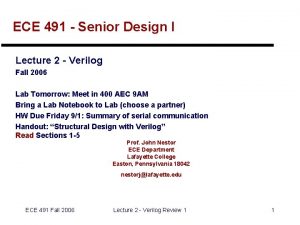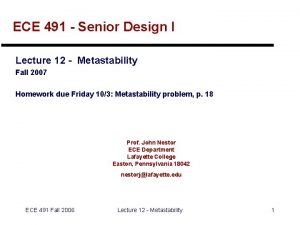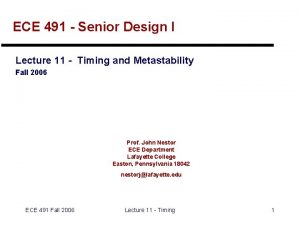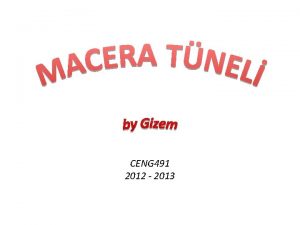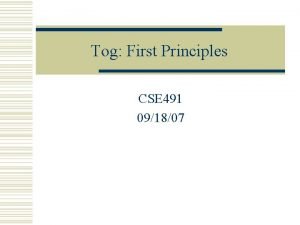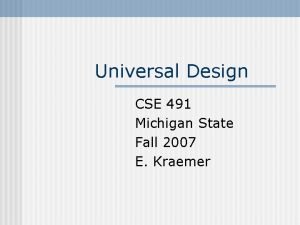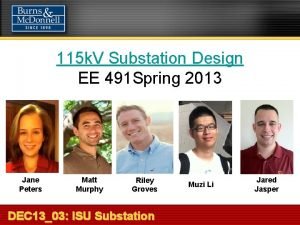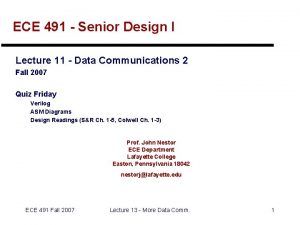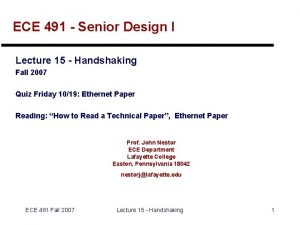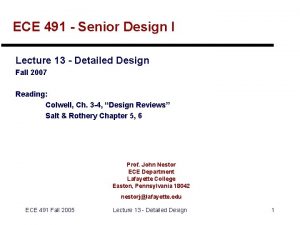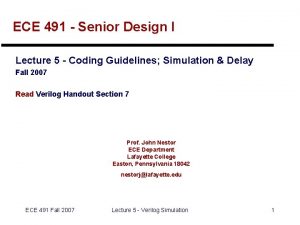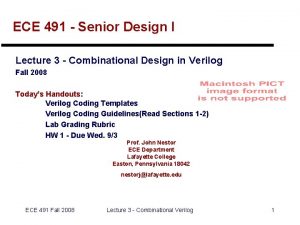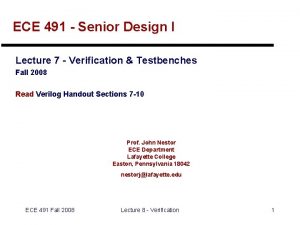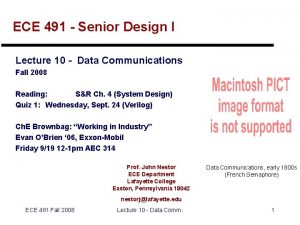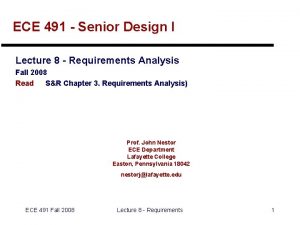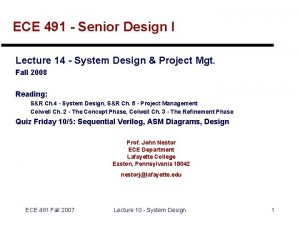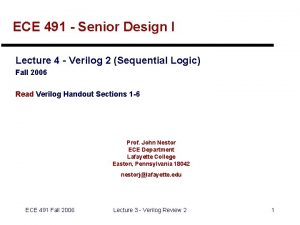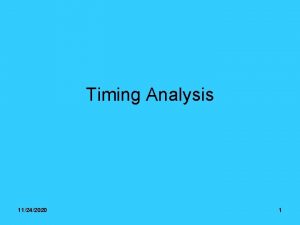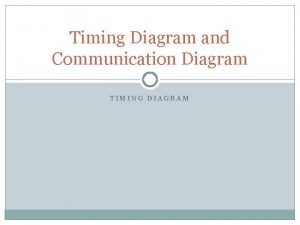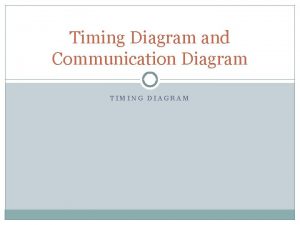ECE 491 Senior Design I Lecture 11 Timing


























- Slides: 26

ECE 491 - Senior Design I Lecture 11 - Timing and Metastability Fall 2006 Prof. John Nestor ECE Department Lafayette College Easton, Pennsylvania 18042 nestorj@lafayette. edu ECE 491 Fall 2006 Lecture 11 - Timing 1

Where we are } Last Time: } Verilog Coding - Quick Recap } The Datapath/Controller Abstraction } Today: } Timing } Synchronizers & Metastability ECE 491 Fall 2006 Lecture 11 - Timing 2

Review - Flip-Flop Timing Characteristics } Propagation Delay t. CQ } Setup time tsetup } Hold time th DQ clk CLK tsetup th D Q ECE 491 Fall 2006 t. CQ Lecture 11 - Timing 3

Review - Clocks in Sequential Circuits } Controls sequential circuit operation } Register outputs change at beginning of cycle } Combinational logic determines “next state” } Storage elements store new state Register Output Combinational Logic Register Input Adder Mux Clock ECE 491 Fall 2006 Lecture 11 - Timing 4

What Limits Clock Frequency? } Propagation delay - tprop • Logic (including register outputs) • Interconnect } Register setup time - tsetup Register Output Combinational Logic Register Input Adder tclock > tprop+ tsetup Mux tclock = tprop+ tsetup + tslack Clock tprop ECE 491 Fall 2006 tsetup Lecture 11 - Timing 5

Timing in FPGA Design - Constraints } The constraints file specifies timing using the TIMESPEC directive #TIMESPEC <name> = FROM : <source> : TO : <dest> : <time>; } In the “s 3 board. v” file - using predefined groups # Time specifications # #TIMESPEC TS 01 = FROM #TIMESPEC TS 02 = FROM #TIMESPEC TS 03 = FROM #TIMESPEC TS 04 = FROM #TIMESPEC TS 05 = FROM #TIMESPEC TS 06 = FROM #TIMESPEC TS 07 = FROM #TIMESPEC TS 08 = FROM ECE 491 Fall 2006 for 50 MHz clock : : : : FFS : TO : FFS : 20 ns; RAMS : TO : FFS : 20 ns; FFS : TO : RAMS : 20 ns; RAMS : TO : RAMS : 20 ns; FFS : TO : PADS : 20 ns; PADS : TO : FFS : 20 ns; PADS : TO : RAMS : 20 ns; RAMS : TO : PADS : 20 ns; Lecture 11 - Timing 6

Synchronizers } Key idea: make sure inputs don’t change at a “bad time” in sequential circuits 00 in 1’ in 1 10 01 in 2 11 in 3 clk in 1 NS 11 10 01 transient ECE 491 Fall 2006 Lecture 11 - Timing 7

Adding Synchronizers } Add a D Flip-Flop on each asynchronous input } Synchronize each input only once } Q: What happens when set up & hold time violated? in 1_a D Q in 1_s in 2_a D Q in 2_s clk ECE 491 Fall 2006 Lecture 11 - Timing 8

Metastability: When bad things happen to good synchronizers Q: What happens when tsu / th constraints violated? A: It depends, but there are three scenarios 1. Circuit correctly records new D value 1. Circuit retains old D value for an extra cycle 3. Metastability - “stuck” between legal 0 and 1 until it “resolves” CLK tsu th D tclk-q Q 1 Q 2 tclk-q Q 3 Resolution Time tr ECE 491 Fall 2006 Lecture 11 - Timing 9

What Metastability Looks Like Image Source: www. fpga-faq. com ECE 491 Fall 2006 Lecture 11 - Timing 10

Metastability } Two stable states } Vo 1=L, Vo 2=H } Vo 1=H, Vo 2=L } One metastable state } Vo 1 = Vo 2 } Ugly characteristic: unbounded recovery time tr Graphic source: J. Rabaey, Digital Integrated Circuits, © Prentice-Hall, 1996 ECE 491 Fall 2006 Metastable point Lecture 11 - Timing 11

Metastability - “Ball on the Hill” Analogy } Sides of hill = stable states } Top of hill = metastable state } Any small “push” (e. g. , noise) will move the ball off the hill and into a stable state ECE 491 Fall 2006 Lecture 11 - Timing 12

Metastability - Bad News / Good News } Bad news } Metastability is unavoidable } Recovery time is theoretically unbounded } Good news } Can empirically measure recovery times } Can use statistics from recovery times to make failure probability arbitrarily small } Most FPGAs are highly resistant to metastability ECE 491 Fall 2006 Lecture 11 - Timing 13

Measuring Metastability Characteristics } Intentionally cause metastability many times } Measure recovery for each occurrence } Fit recovery times to exponential function Number Of Occurrences tclk-q ECE 491 Fall 2006 Recovery Time Lecture 11 - Timing 14

Designing with Metastability } A synchronizer design at a given clock period provides a fixed amount of resolution time tr } Definition: a synchronization failure occurs when actual recovery time tr-actual > tr } For a given flip-flop, the mean time between failure (MTBF) is given by the formula fclk - System clock freq. a - asynchronous input rate of change. t - empirically derived constant To - empirically derived constant tr - time available for resolution ECE 491 Fall 2006 Lecture 11 - Timing 15

Determining Resolution Time tr } Must leave time for system to respond properly after resolution tr = tclk - tsetup - tprop tsu DQ DQ Comb. Logic clk ECE 491 Fall 2006 Lecture 11 - Timing 16

Resolution Time Example } Suppose that = 100 MHz (tclk = 10 ns) } a = 1 MHz } tprop = 6. 7 ns } tsetup = 1 ns } fclk } Calculate tr: } tr = tclk - tsetup - tprop } tr = 10 ns - 6. 7 ns -1 ns = 2. 3 ns ECE 491 Fall 2006 DQ tprop=6. 7 ns tsu=1 ns DQ Comb. Logic clk Lecture 11 - Timing 17

MTBF Calculation Example } “Typical” values for a 0. 25µm ASIC library flip-flop } t = 0. 31 ns } To = 9. 6 as } tr = 2. 3 ns “a” = 10 -18 } MTBF = 20. 1 days - unacceptable! ECE 491 Fall 2006 Lecture 11 - Timing 18

What happens if we halve fclk? } Suppose that } } fclk = 50 MHz (tclk = 20 ns) a = 1 MHz tprop = 6. 7 ns tsetup = 1 ns } Calculate tr and MTBF: } tr = tclk - tsetup - tprop } tr = 20 ns - 6. 7 ns -1 ns = 12. 3 ns } MTBF = 5. 7 X 1028 seconds = 1. 8 X 1021 years ECE 491 Fall 2006 Lecture 11 - Timing 19

Reality Check: What about FPGAs? } Metastability info in FPGAs is scarce } One refrerence: Peter Alfke, “Metastability Delay and Mean Time Between Failures in Virtex-II Pro FFs”, October 2002. } Some statistical measurements for Virtex-II Pro FPGAs } Major conclusion: Metastability issues are not much of a problem ECE 491 Fall 2006 Lecture 11 - Timing 20

MTBF Calculation Example - Virtex II Pro } Values from a Xilinx Technical note: } t = 0. 02 ns - 0. 05 ps (assume 0. 05 ps) } To = not given, but assume = 9. 6 as “a” = 10 -18 } tr = 2. 3 ns } MTBF = 9. 89 X 1022 seconds = 7, 53 X 1016 years - not to worry! ECE 491 Fall 2006 Lecture 11 - Timing 21

Alternative: Dual-Stage Synchronizer } Increased value for tr: tr = tclk - tsu - tpr tr = 10 ns - 1 ns = 9 ns DQ tprop tsu DQ DQ Comb. Logic clk ECE 491 Fall 2006 Lecture 11 - Timing 22

Dual-Stage MTBF Calculation } “Typical” values for a 0. 25µm ASIC library flip-flop } t = 0. 31 ns } To = 9. 6 as } tr = 9 ns “a” = 10 -18 } MTBF = ? ECE 491 Fall 2006 Lecture 11 - Timing 23

Other Synchronizer Alternatives } Metastability-hardened SYNC flip-flops } Multiple-Stage Synchronizers } Reduced-Clock Synchronizers ECE 491 Fall 2006 Lecture 11 - Timing 24

What to Do About Metastability } } } Start with simple synchronizer (single flip-flop) Calculate MTBF for your system Decide if it's acceptable If not, use a different design OR different design: } Two-stage flip-flop } Reduced-clock synchronizers ECE 491 Fall 2006 Lecture 11 - Timing 25

Coming Up } } System Design ASM Diagrams Manchester Coding Ethernet ECE 491 Fall 2006 Lecture 11 - Timing 26
 Ece 491
Ece 491 Mttr formula
Mttr formula Ece 491
Ece 491 Ece 491
Ece 491 Ece senior design gatech
Ece senior design gatech 01:640:244 lecture notes - lecture 15: plat, idah, farad
01:640:244 lecture notes - lecture 15: plat, idah, farad Ba491
Ba491 External analysis in strategic management
External analysis in strategic management Pngpa
Pngpa Cs 491 bilkent
Cs 491 bilkent Bahri tokmak
Bahri tokmak Tog on interface
Tog on interface Cse 491
Cse 491 Ee 491
Ee 491 Ee 491
Ee 491 Ucf senior design
Ucf senior design Ncsu csc senior design
Ncsu csc senior design Ee senior design project ideas
Ee senior design project ideas Eurocode reinforcement detailing
Eurocode reinforcement detailing Elemen urban design
Elemen urban design Principles of interior design ppt
Principles of interior design ppt Lecture hall background
Lecture hall background Game design lecture
Game design lecture Computer-aided drug design lecture notes
Computer-aided drug design lecture notes Cmos vlsi design lecture notes
Cmos vlsi design lecture notes Pulsar timing
Pulsar timing Farmtek timer display
Farmtek timer display
